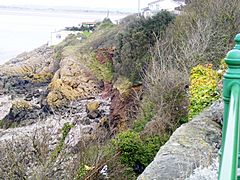Spring Cove Cliffs facts for kids
| Site of Special Scientific Interest | |
 |
|
| Area of Search | Avon |
|---|---|
| Coordinates | 51°21′26″N 2°59′32″W / 51.35736°N 2.99233°W |
| Interest | Geological |
| Area | 2.0 hectares (0.020 km2; 0.0077 sq mi) |
| Notification | 1952 |
Spring Cove Cliffs is a special place near the town of Weston-super-Mare in North Somerset. It covers about 2.0 hectares (about 5 acres). This area was marked as a "Site of Special Scientific Interest" (SSSI) in 1952.
An SSSI is a protected area. It means the place is very important for its plants, animals, or rocks. Spring Cove Cliffs is special because of its geology. It helps us understand how Earth looked long ago.
Spring Cove Cliffs: A Window to Earth's Past
This site is listed in the Geological Conservation Review. This review highlights places with important geological features. Spring Cove Cliffs shows amazing rock layers and volcanic rocks. These features help scientists study Earth's history.
What Makes These Cliffs Special?
The cliffs show a sequence of volcanic rocks. These rocks are about 18 meters (59 feet) thick. They formed during a time called the Dinantian period. This was a very long time ago.
These rocks formed south of a large landmass. This ancient landmass is called St George’s Land. The rocks here are special because they are volcanic. They also formed underwater.
How Rocks Tell a Story
The lava at Spring Cove Cliffs is unique. Some parts of it are "pillowed." This means the lava cooled quickly underwater. It formed rounded, pillow-like shapes.
Scientists believe this lava flowed onto a sloping seafloor. The way the lava and other rocks are mixed tells a story. It shows how volcanoes erupted underwater. It also shows how sediments settled around them. These sediments later turned into carbonate rocks.
Studying these cliffs helps us learn about ancient oceans. It also teaches us about volcanic activity from millions of years ago.

